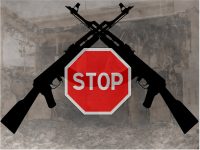Terror: On Words, Power and Perception

The stock-in-trade of the media is words.
Sometimes dry, sometimes emotional, these words greet the public with an air of factual authority – whatever the platform.
Recently in Australia reportage on the topic of ‘terror’ has been thought-provoking at times, and remarkably off-base at other times.
This post explores the troubling repercussions of media mishandling within the arena of ‘terror’.
Truth and error
In one example, an Australian military officer reports that he has been accosted outside of his home by two males of ‘middle eastern’ appearance.
The media is appalled by the notion of this patriotic, innocent ADF member being attacked by enemies.
“Sailor bashed in the street,” proclaims a NewsCorp publication.
Later the officer retracts the allegation. Entirely.
The ADF and police are of course investigating the situation – and yet there we have the entire saga played out across our various media platforms from beginning to end.
Considering the number of general assaults occurring across Australia on any given day, why was this one given any column space at all?
Why now?
Tragic identities
And in another recent incident involving the Fairfax press, the story of a deceased 18-year-old was splashed on the front pages of the organisation’s key papers.
The young Afghani-born Melbourne man in question, Numan Haider, had been involved in a tragic episode with two policemen.
The attack has been widely described as a terror-related incident. The police were stabbed. Haider was shot dead.
The Fairfax coverage energetically described the incident and the aftermath, complete with a young man’s photo.
Yet, incredibly – this was not a photo of Numan Haider!
Because of an alleged image mix-up, a completely unrelated young man (who is decidedly alive) was featured in the photo.
An upstanding young fellow from a great local Afghani family, this second youth now has an incredible fear of being confronted in public as a ‘terrorist.’
So not only is the public overloaded with the story of a troubled teen in a car park with police, our collective subconscious is also fed a second image of a hapless youth of certain ethnicity, surrounded by sensationalist copy on terror.
Apology or not, the damage is done.
Majority rules
Police powers grow, government actions intensify and we of course access the media in order to work out exactly what is going on regarding terror threats.
Yet when mistakes are made in a climate of uncertainty, a media retraction can’t undo what the public mind has already absorbed.
Of course since time immemorial, societies have had a habit of turning on certain groups during periods of fear.
When the chips are down, is doesn’t pay to be ‘different’ in the eyes of the masses.
It is one thing to talk of freedom and equality in times of calm, but this pleasant rhetoric can quickly become a lie when fear enters a community.
Characteristics that might ordinarily be considered unremarkable – or at the most an individual quirk – soon become fodder for angry stereotyping.
A 14-year-old boy is screaming obscenities out of a car, a mosque is attacked with stones, a home is subjected to a drive-by shooting, veiled women are assaulted in the streets… where does it end?
We have seen communists, fascists, Asians and now Muslims become vilified and targeted, often because of the actions of isolated groups of wrongdoers.
The problem inherent in demonising one group is that it serves to do the very thing feared by the masses – increase the fear and radicalisation of impressionable members within that particular group.
Retaliation is the possibility, when we make an enemy out of somebody who simply never was one.
Surely this is counter-productive to what we sought out to achieve.
When MPs stumble over the meaning of ‘Sharia law’ and innocent young men have their photo wrongly splashed across a newspaper, surely it’s time to stop and take a breath?
Knowing that a majority will always hold suspicion for what it doesn’t fully understand, it surely falls to government and media to refrain from boxing at shadows themselves.
Word limits
As indicated above, part of the remit of government is to defend and protect the people of a nation.
In Australia’s case, it is certainly reasonable to be watching, analysing and preparing for any potential problems related to extremist activity.
Yet the words of government – the words of power – must be used judiciously.
When in the form of executive action or legislation to beef up police powers, such words will necessarily be applied with painstaking care.
Without extreme clarity about what these powers can be used for, individual officers might well be left with a wide-open discretion regarding the ‘targets’ in question.
And when talking with the media about the potential for terrorist activity, any government communication regarding ethnicity or religion must be accurate, respectful and free of broad-ranging stereotypes.
Truth in a global village
The human community is of course a social place.
It’s one great chatty village where multiple ideas, reactions, facts and gossip swirl with abandon.
Just like a physical village, we also have gates and gatekeepers for all of our public ideas and actions, so that fact is hopefully separated from fiction.
When the gates are broken or gatekeepers fall asleep on the job, then information can be muddled into something far from either truth or reality.
As Australia works against the threat of terror – and this is an incredibly vital task – those at the source of information should be tireless in getting all facts right.
Sensationalism might sell papers or feed online stats, but costs must be scrupulously weighed.
If not, the opportunity is there for mistakes, exaggeration and hype to develop into tragedy.
Because in any community, fear of the unknown can very easily segue into unnecessary targeting of people and groups.
Ancient villages had scapegoats, where blame was laid at the feet of a singled-out animal, person or group in order to appease some higher power.
Let’s guard against this ugliness developing within our great country.






